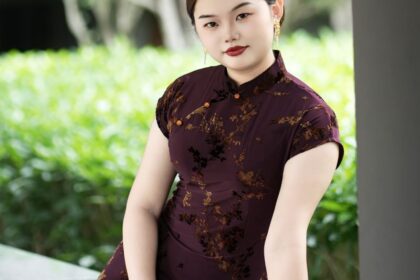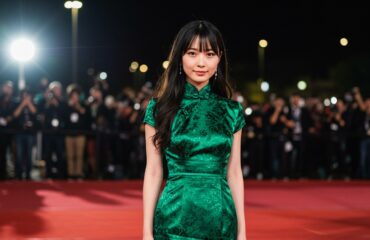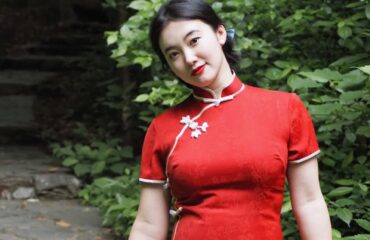
The cheongsam, or qipao, stands as one of the most iconic and recognizable garments in the world. Its elegant, form-fitting silhouette, high mandarin collar, and delicate knot buttons evoke a sense of timeless grace and Eastern sophistication. Yet, the dress we recognize today is not an ancient, unchanging costume but a relatively modern creation, a product of dramatic social and cultural shifts in 20th-century China. Its journey is a fascinating narrative of transformation, reflecting the changing role of women, the fusion of Eastern and Western aesthetics, and the very pulse of a nation undergoing profound change. From the loose robes of the Manchu court to the dazzling glamour of Old Shanghai, and from a symbol of bourgeois decadence to a celebrated icon on the global stage, the evolution of the cheongsam is a story woven into the very fabric of Chinese history.
1. The Manchu Origins and Early Republican Reforms
The direct ancestor of the cheongsam is not the flowing, wide-sleeved attire of Han Chinese women from dynasties past, but the changpao (長袍), or “long robe,” of the Manchu people who founded the Qing Dynasty (1644-1912). Originally, the changpao was a practical, straight-cut, A-line garment worn by both men and women. It was designed for the equestrian lifestyle of the Manchus, featuring a simple, one-piece construction that hung loosely from the shoulders to the ankles, with slits on the sides for ease of movement. It was utilitarian, modest, and designed to conceal the figure rather than accentuate it.
The fall of the Qing Dynasty in 1912 and the establishment of the Republic of China marked a pivotal turning point. With the old imperial structure dismantled, a new wave of modernization and Westernization swept across the country. Chinese society began to question and discard old traditions, including dress codes. It was in this environment of change that the transformation of the changpao began. Young, educated women, particularly students, started to adapt the formerly masculine or unisex robe, tailoring it to be more slender and feminine. This early version, often called the “Republican cheongsam,” retained the length and basic structure of the changpao but was significantly more streamlined.
| Feature | Qing Dynasty Manchu Changpao | Early Republic Cheongsam (c. 1910s) |
|---|---|---|
| Silhouette | Wide, A-line, loose-fitting | Straight, becoming more slender |
| Fit | Concealed the body shape completely | Loosely followed the body’s contours |
| Sleeves | Long and wide, often with horse-hoof cuffs | Bell-shaped, wrist-length sleeves |
| Material | Heavy silks, cotton, fur-lined for warmth | Lighter silks, cotton, patterned fabrics |
| Social Context | Official and everyday attire of the Manchu Bannermen | Symbol of modernity and education for young women |
2. The Golden Age: Shanghai’s Glamour in the 1920s-1940s
If the cheongsam was born in the early Republic, it came of age in the vibrant, cosmopolitan metropolis of Shanghai during the 1920s, 30s, and 40s. As the “Paris of the East,” Shanghai was a melting pot of international trade, culture, and ideas. This environment became the crucible for the cheongsam’s most dramatic and iconic evolution.
Western tailoring techniques were introduced and enthusiastically adopted by Shanghai’s dressmakers. Darts were added at the bust and waist, set-in sleeves replaced the traditional one-piece sleeve-and-body cut, and the silhouette became daringly body-hugging. The cheongsam transformed from a modest robe into a powerful statement of female sensuality and confidence. This period saw rapid experimentation with every aspect of the dress:
- Hemlines: Rose and fell with dizzying speed, from ankle-length in the mid-1920s to just below the knee in the early 1930s, a scandalous height for its time.
- Sleeves: Varied from long and belled to short, capped, or completely sleeveless, catering to different seasons and occasions.
- Collars: The Mandarin collar remained a key feature, but its height fluctuated from fashionably high to comfortably low.
- Materials: Beyond traditional silk and brocade, designers began using imported fabrics like velvet, lace, and sheer georgette, often adorned with intricate embroidery or Art Deco-inspired patterns.
The cheongsam became the uniform of the modern Chinese woman—from glamorous movie stars like Ruan Lingyu and Zhou Xuan to sophisticated socialites, artists, and intellectuals. It was no longer just a dress; it was a symbol of liberation and cosmopolitan identity.
3. Decline in the Mainland and Preservation Abroad
The establishment of the People’s Republic of China in 1949 brought the golden age of the cheongsam to an abrupt halt in the mainland. The new communist government viewed the form-fitting, elegant dress as a symbol of bourgeois decadence and Western influence, starkly at odds with its ideals of proletarian austerity. The cheongsam was discouraged and largely disappeared from public life, replaced by unisex, utilitarian clothing like the simple tunic and trousers known as the “Mao suit.”
However, as the dress vanished from mainland China, it found new life in other parts of the world. Tailors and their wealthy patrons who had fled the mainland, particularly to Hong Kong and Taiwan, brought their skills and sartorial traditions with them. In Hong Kong, the cheongsam continued to be worn as daily attire through the 1950s and 60s. It became more standardized, often seen as elegant work attire or formal wear. This is the style immortalized in Wong Kar-wai’s film In the Mood for Love, where Maggie Cheung’s character wears a stunning array of perfectly tailored cheongsams that define the restrained elegance of the era. In these overseas communities, the cheongsam became a powerful link to cultural heritage and a symbol of Chinese identity in a foreign land.
4. The Modern Renaissance and Global Fusion
Beginning in the 1980s, with China’s economic reforms and reopening to the world, a cultural renaissance took place. There was a renewed interest in traditional arts and heritage, and the cheongsam was rediscovered and reclaimed. However, it did not return as an everyday garment. Instead, it was reimagined for a new era.
Today, the cheongsam thrives in multiple forms. It is a popular choice for significant occasions like weddings, Lunar New Year celebrations, and diplomatic functions. Simultaneously, it has become a canvas for modern and international designers. We now see a fascinating fusion of styles: the classic Mandarin collar or side slit might be incorporated into a cocktail dress, a business suit, or even a casual top. Fabrics range from traditional brocades to contemporary choices like denim, knit jersey, and printed cotton.
This modernization has been greatly facilitated by the digital age. Brands and online platforms, such as Cheongsamology.com, now offer a wide range of styles, from bespoke traditional pieces to ready-to-wear modern interpretations, making the garment accessible to a global audience. The cheongsam is no longer confined by geography or rigid tradition; it is a global fashion statement.
| Aspect | Traditional Cheongsam (Golden Age) | Modern Cheongsam (Post-1980s) |
|---|---|---|
| Primary Use | Daily wear, formal events, social gatherings | Special occasions (weddings, parties), ceremonial wear |
| Silhouette | Strictly body-hugging, following a defined pattern | Varied: classic fit, A-line, mermaid, shortened versions |
| Fabrics | Silk, brocade, lace, velvet, cotton | All traditional fabrics plus denim, jersey, synthetics, leather |
| Design Elements | Focused on fit, collar height, sleeve length | Fusion with Western styles, asymmetrical cuts, zippers, prints |
| Accessibility | Required a skilled tailor for a custom fit | Available ready-to-wear, online, and in global boutiques |
The cheongsam has graced international red carpets, worn by celebrities of both Asian and non-Asian descent, and has been reinterpreted by luxury fashion houses like Dior, Gucci, and Ralph Lauren. Its journey from a modest Manchu robe to a global fashion icon is a testament to its aesthetic power and its remarkable capacity for reinvention.
The story of the cheongsam is a mirror reflecting a century of profound change. It is a garment that has carried the weight of tradition, the thrill of modernity, the shadow of political ideology, and the pride of cultural identity. Its enduring appeal lies in its unique blend of restraint and allure, tradition and innovation. As it continues to evolve, the cheongsam proves that it is not a historical relic locked in a museum but a living, breathing piece of cultural art, constantly being re-drawn and re-imagined, ensuring its elegance will continue to captivate the world for generations to come.

